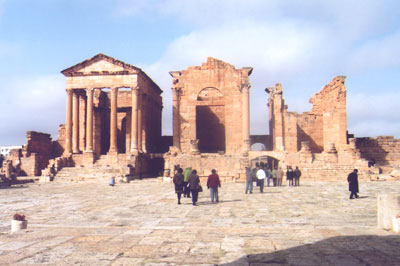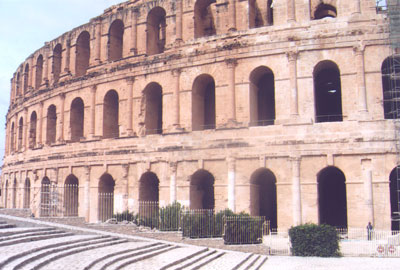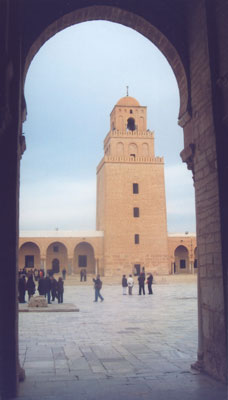Tunisian Odyssey: The Middle
This item appears on page 61 of the August 2010 issue.
by Julie Skurdenis (Second of three parts)
The following describes the middle part of an odyssey that began in Sidi Bou Said, a suburb of Tunis, capital of Tunisia, and at the nearby archaeological site of Carthage.
During the first seven days of our 22-night private guided trip, my husband, Paul, and I visited seven archaeological sites (three of them UNESCO World Heritage Sites) plus the picture-postcard village of Sidi Bou Said, overlooking the Gulf of Tunis; the world-famous Bardo museum; the Medina of Tunis; the mountains and cork oak forests of northwestern Tunisia close to the Algerian border, and the Cap Bon area of resorts, fishing villages and vineyards.
More was to come. This middle portion of our trip was still primarily in the northern half of Tunisia and still full of the Numidian, Phoenician and Roman archaeological sites that make Tunisia one of the must-see countries for those interested in the past.
Top on our archaeological list on this segment was El Jem, a UNESCO World Heritage Site. In the third century AD, El Jem (then called Thysdrus) was a wealthy Roman city with amphitheaters, public baths, a circus and luxurious villas. Practically all that’s left now is a coliseum.
But what a coliseum it is! Over 100 feet high, with three tiers of seating, it once was capable of holding as many as 40,000 spectators. It was the third-largest coliseum in the Roman world, after those of Rome and Capua. Visitors can walk along underground corridors where wild animals were caged and where gladiators once awaited combat with either each other or animals.
El Jem has a fabulous museum displaying mosaics that once decorated the villas of ancient Thysdrus. It rivals the collection in Tunis’ Bardo Museum.
Underground villas
Bulla Regia is not on the UNESCO World Heritage List but should be. Originally Carthaginian, then Numidian, it reached its apex under the Romans in the second and third centuries AD.
Unique here are the underground villas the Romans built to escape the intense summer heat. One would enter a villa at ground level and descend to a colonnaded courtyard surrounded by a dining room (triclinium) and bedrooms. Many of these underground villas still have their mosaic floors intact, including the House of Amphitrite with its large mosaic of Venus, sea monsters and cupids riding dolphins.
Sbeitla, too, is unique. The monumental Antonine gate, dedicated to the 15th Roman emperor Antoninus Pius, who ruled from AD 138 to 161, leads to a large paved forum. It’s dominated not by the usual one temple to the triad of Roman gods Jupiter, Juno and Minerva but by three separate temples. The Roman gods were supplanted by the Christian god, as witnessed by the nearby ruins of three fourth- to fifth-century-AD churches atop older temples.
The Arch of Septimius Severus at Haidra, named in honor of the first Roman emperor to be born in Africa (in Leptis Magna in Libya in AD 145), stands forlornly overlooking ruins around it. But nearby is the enormous fortress built by the Byzantines in the middle of the sixth century AD when they recaptured this area from the Vandals, who had migrated from Spain in the preceding century.
At Chemtou, site of the largest marble quarry in North Africa, large Numidian stone tombs lie scattered beneath the Roman Forum that was built on top of them.
Also at Makthar, layers of history lie atop each other — a fifth-century-AD Christian basilica within a second-century-AD Roman bath; a Roman temple to Apollo atop a much earlier Carthaginian temple to Baal Hammon; second-century-AD Roman thermal baths converted into a Byzantine fort in the sixth century AD. . . .
Villages and markets
As with the first part of our trip, although we love visiting archaeological sites, it wasn’t the only thing we did.
We also meandered through the lanes of old Berber villages. We explored the Dar Charait Museum in Tozeur, where lifelike scenes re-create Tunisian life, including a wedding and a hammam (public bathhouse). We strolled the streets of Nefta admiring the ornate ornamental brickwork of the old houses and watching an Italian film crew assembling a caravan of camels for a film shoot. And we bargained for Tuareg jewelry in the souk in Douz, later sipping mint tea at an open-air café.
Great Mosque
The highlight of these nonarchaeological sights was, however, the Great Mosque in Kairouan. Kairouan is considered by many to be the fourth-holiest city in the Islamic world, after Mecca, Medina and Jerusalem. Yet another UNESCO World Heritage Site, the Great Mosque is one of the oldest mosques, built originally around AD 670, only 38 years after Muhammad’s death.
A colonnade encloses a marble courtyard with a minaret which may date from the eighth century AD. Enormous wooden doors at one end of the courtyard open to a prayer hall with pillars supporting horseshoe arches. Non-Moslems cannot enter the prayer hall, but they can peek in at the doorway to view the vast interior lit by chandeliers.
If you go…
The company we selected, TunisUSA (Wayne, PA; 888/474-5502 or 484/754-0086, www.TunisUSA.com), specializes in Tunisian travel although it also offers a menu of other destinations, including Malta, Iran, India, Turkey, and Libya. TunisUSA put together a customized, 22-night trip for us with private car, driver and a guide who introduced us to the best this remarkable country has to offer.
With mostly deluxe hotels and boutique properties, some meals and one domestic flight, the trip cost us approximately $10,000, excluding international airfare.



